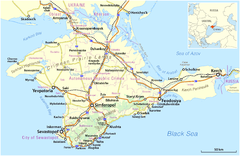
Back Ҟрым Abkhazian Krim Afrikaans Krim ALS ክሪሜያ Amharic Peninsula de Crimea AN Taurica ANG القرم Arabic قريميا ARY شبه جزيرة كريميا ARZ Crimea AST
 Map of the Crimean Peninsula | |
 | |
| Geography | |
|---|---|
| Location | Eastern Europe |
| Coordinates | 45°18′N 34°24′E / 45.3°N 34.4°E |
| Adjacent to | |
| Area | 27,000 km2 (10,000 sq mi) |
| Highest elevation | 1,545 m (5069 ft) |
| Highest point | Roman-Kosh |
| Status | Internationally recognized as Ukrainian territory occupied by Russia (see Political status of Crimea) |
Ukraine (de jure but not in control) | |
| Northern Arabat Spit (Henichesk Raion) Autonomous Republic of Crimea Sevastopol | |
| Largest settlement | Sevastopol |
Russia (de facto control) | |
| Republic of Crimea Sevastopol | |
| Largest settlement | Sevastopol |
| Demographics | |
| Demonym | Crimean |
| Population | |
| Pop. density | 84.6/km2 (219.1/sq mi) |
| Additional information | |
| ISO code | UA-43 |

Crimea[a] (/kraɪˈmiːə/ ⓘ kry-MEE-ə) is a peninsula in Eastern Europe, on the northern coast of the Black Sea, almost entirely surrounded by the Black Sea and the smaller Sea of Azov. The Isthmus of Perekop connects the peninsula to Kherson Oblast in mainland Ukraine. To the east, the Crimean Bridge, constructed in 2018, spans the Strait of Kerch, linking the peninsula with Krasnodar Krai in Russia. The Arabat Spit, located to the northeast, is a narrow strip of land that separates the Syvash lagoons from the Sea of Azov. Across the Black Sea to the west lies Romania and to the south is Turkey. The population is 2.4 million,[1] and the largest city is Sevastopol. The region has been under Russian occupation since 2014.
Called the Tauric Peninsula until the early modern period, Crimea has historically been at the boundary between the classical world and the steppe. Greeks colonized its southern fringe and were absorbed by the Roman and Byzantine Empires and successor states while remaining culturally Greek. Some cities became trading colonies of Genoa, until conquered by the Ottoman Empire. Throughout this time the interior was occupied by a changing cast of steppe nomads, coming under the control of the Golden Horde in the 13th century from which the Crimean Khanate emerged as a successor state. In the 15th century, the Khanate became a dependency of the Ottoman Empire. Lands controlled by Russia[b] and Poland-Lithuania were often the target of slave raids during this period. In 1783, after the Russo-Turkish War (1768–1774), the Russian Empire annexed Crimea. Crimea's strategic position led to the 1854 Crimean War and many short lived regimes following the 1917 Russian Revolution. When the Bolsheviks secured Crimea, it became an autonomous soviet republic within the Russian Soviet Federative Socialist Republic. It was occupied by Germany during World War II. When the Soviets retook it in 1944, Crimean Tatars were ethnically cleansed and deported under the orders of Joseph Stalin, in what has been described as a cultural genocide. Crimea was downgraded to an oblast in 1945. In 1954, the USSR transferred the oblast to the Ukrainian Soviet Socialist Republic on the 300th anniversary of the Pereyaslav Treaty in 1654.
After Ukrainian independence in 1991, the central government and the Republic of Crimea clashed, with the region being granted more autonomy. The Soviet fleet in Crimea was also in contention, but a 1997 treaty allowed Russia to continue basing its fleet in Sevastopol. In 2014, the peninsula was occupied by Russian forces and annexed by Russia, but most countries recognise Crimea as Ukrainian territory.[2]
- ^ a b Численность населения Российской Федерации по муниципальным образованиям на 1 января 2021 года [The population of the Russian Federation by municipalities as of January 1, 2021]. Russian Federal State Statistics Service (in Russian). Archived from the original (XLS) on 4 February 2021. Retrieved 31 January 2021.
- ^ "Ukraine's president pledges to 'return' Russia-annexed Crimea". Al Jazeera. 23 August 2021. Retrieved 27 June 2024.
Cite error: There are <ref group=lower-alpha> tags or {{efn}} templates on this page, but the references will not show without a {{reflist|group=lower-alpha}} template or {{notelist}} template (see the help page).

